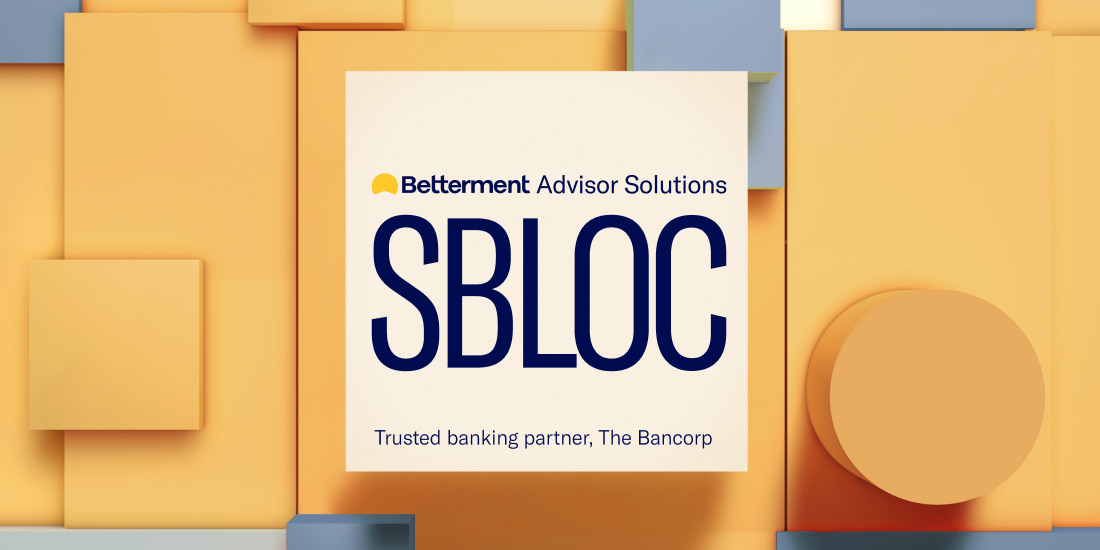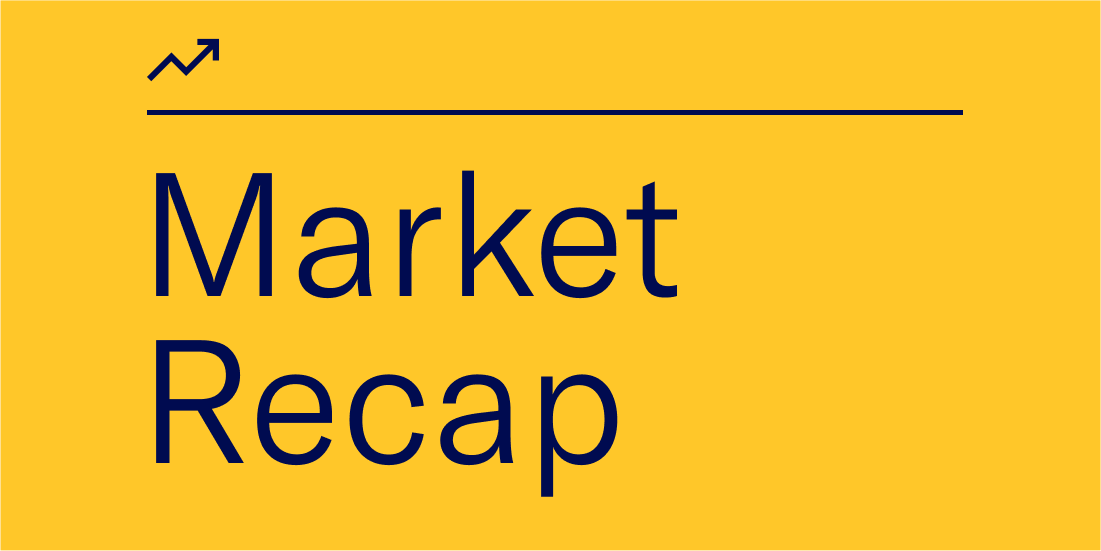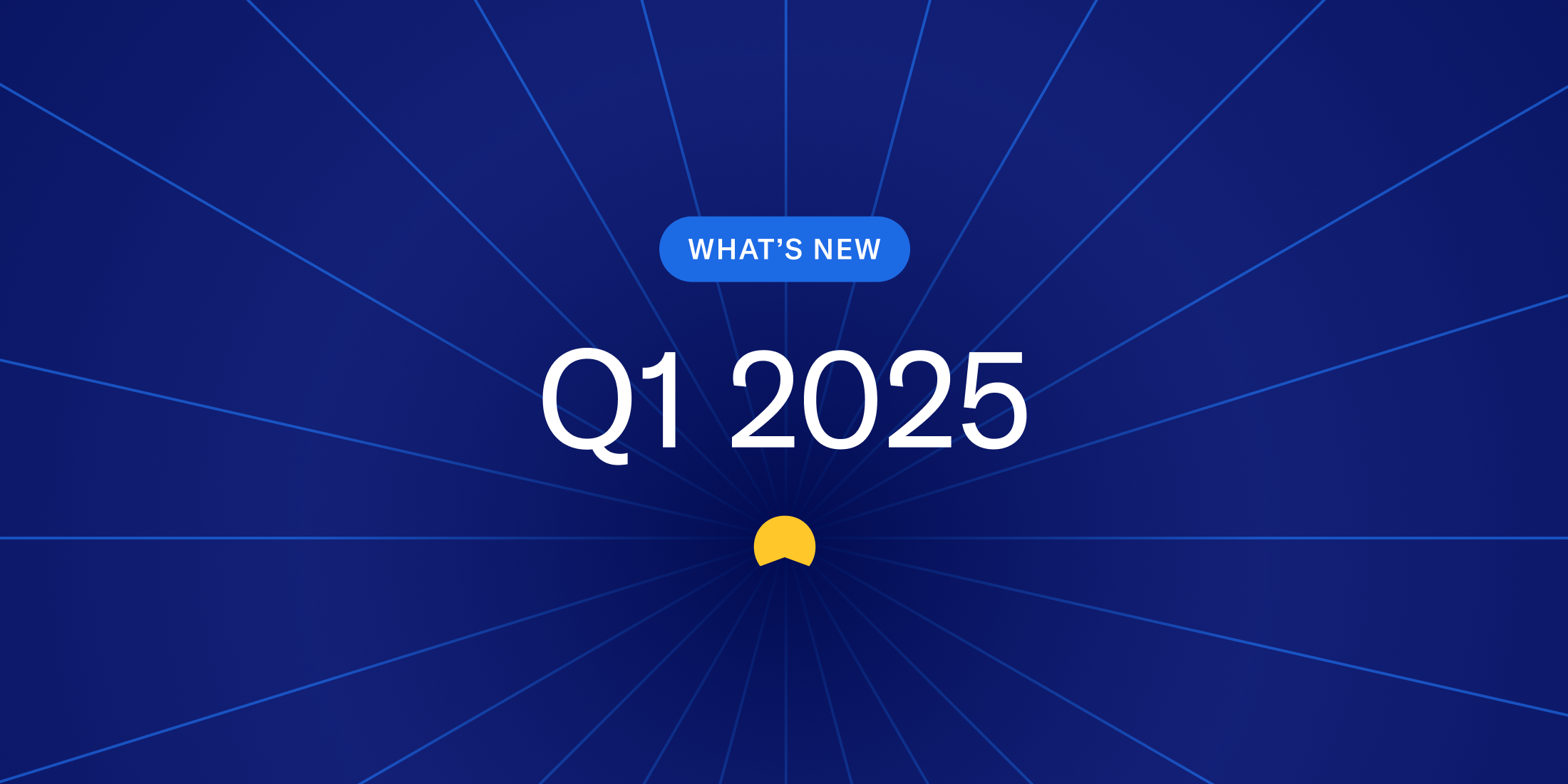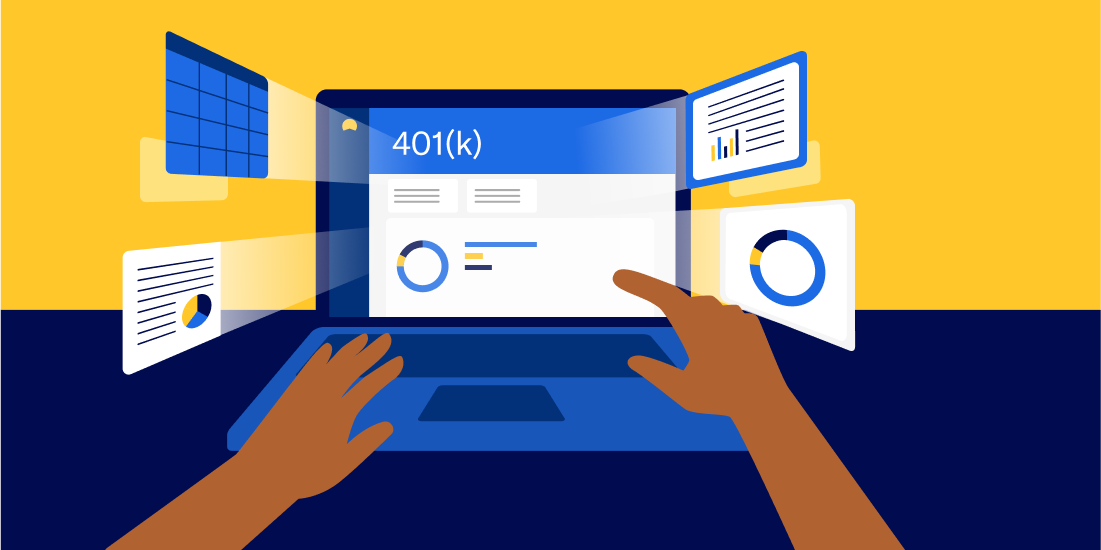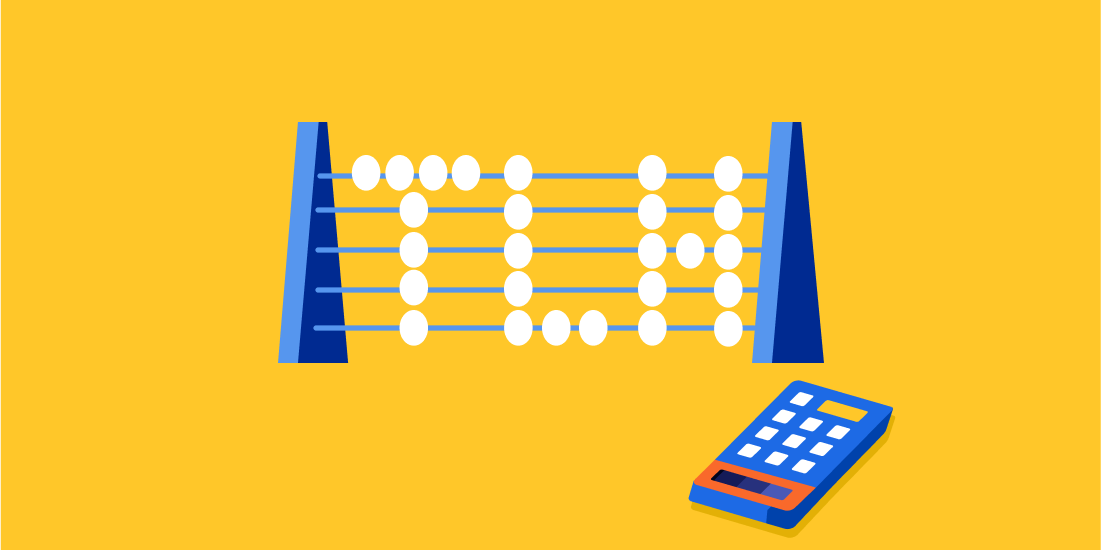Advisor Resources

Sort by:
-
![]()
How to build high-net-worth client relationships with an SBLOC
How to build high-net-worth client relationships with an SBLOC Apr 22, 2025 9:00:00 AM Learn 5 benefits of offering an SBLOC for your firm, and how clients can leverage this modern borrowing tool to keep their investments working for them. Securities-Backed-Lines of Credit (SBLOCs) are offered by The Bancorp to Betterment clients. Betterment is not a bank. See more below. High-net-worth clients often face the problem of needing liquidity, but not wanting to compromise their long-term portfolios and interrupt their wealth management plans. You can provide the solution to this problem. Offering an SBLOC allows your firm to meet clients’ liquidity needs. 5 benefits of offering an SBLOC for your firm Incorporating SBLOCs into your advisory practice shows your commitment to providing innovative and client-centric financial solutions. Many prospective or current clients may not be aware of what an SBLOC is, allowing your firm to leverage its benefits to: Attract high-net-worth clients: Use the SBLOC in your marketing materials and in conversations with prospective clients. The flexibility to borrow against a portfolio without disrupting investment gains can be a strong selling point to high-net-worth clients. Deepen client trust and increase retention: As you learn about your client’s financial and life goals, you can offer the SBLOC as part of financial planning conversations. Because of its flexibility, an SBLOC is a powerful planning tool that can be used to benefit a client in many situations (more on that below). Retain investment strategies: By providing liquidity without requiring your clients to sell their investments, an SBLOC allows your firm to stick to long-term strategies. This means you can maintain asset allocation for clients, ultimately helping you preserve their portfolios. Add debt management and liquidity into your planning: With an SBLOC, you can proactively help clients incorporate debt into their financial planning. But an SBLOC also gives clients immediate access to funds when unexpected opportunities or needs arise. The ability to use an SBLOC proactively or reactively adds an extra layer of flexibility to your overall wealth management planning tools. Manage both sides of a client’s balance sheet: Offering an SBLOC enables you to address both the asset and liability sides of a client’s financial picture. While clients continue growing their investment portfolios, the SBLOC provides a structured way to manage liabilities, creating a more holistic and balanced financial strategy. Common ways clients use an SBLOC Although not for purchasing securities, clients can use an SBLOC for many purposes—it’s really based on their needs and goals. Here are several practical use cases that you can share with clients: Purchase or renovate a home Clients looking to invest in real estate might not want to disturb their investment portfolios. An SBLOC can provide the funds needed for a down payment or for home renovations, allowing clients to secure or enhance a property while keeping their portfolio intact. It can also serve as a smart bridge loan for buyers, purchasing a new home while their current one is still on the market. Pay inheritance, estate, or income taxes Large tax bills from inheritance, estate planning, or income taxes can strain liquidity. With an SBLOC, clients can cover these obligations without the need to liquidate investments at inopportune times, preserving both their tax strategy and long-term growth potential. Finance business expenses Entrepreneurs and business owners often require flexible financing to cover operational expenses, expansion initiatives, or unforeseen costs. An SBLOC offers a non-disruptive way to access capital, letting them invest in their business while maintaining their personal portfolio strategy. Pay college tuition For clients planning for higher education, an SBLOC can help cover college tuition and related expenses. This solution provides immediate funds, enabling clients to meet educational needs without having to sell investments that could be yielding returns over time. Manage medical bills Unexpected medical expenses can be financially straining. An SBLOC offers a ready source of liquidity to manage high medical bills, ensuring clients can address their healthcare needs promptly while continuing to benefit from a long-term investment portfolio. Pay for a wedding Weddings can be one of life’s most memorable—and costly—events. Instead of disrupting their investment strategy, clients can use an SBLOC to cover wedding expenses, enjoying their big day without sacrificing future financial growth. The Betterment SBLOC process Betterment Advisor Solutions, in partnership with The Bancorp, has streamlined the SBLOC process to ensure a swift and efficient experience for both advisors and clients. Automated application: Clients benefit from a simple, automated application process that can be completed quickly, ensuring access to liquidity when needed. Collateral pledge: Eligible securities held in Betterment taxable legal accounts—including individual, joint, and trust accounts—are pledged as collateral. This protects the client’s portfolio while securing the credit line. Establishing the credit line: The Bancorp assesses the portfolio’s value to determine the credit line. Typically, clients can borrow between 50% and 95%* of the value of their pledged assets, depending on the nature and stability of the investments. Accessing and repaying funds: Once established, the credit line is available for draws as needed. Clients pay only interest on the outstanding balance each month, with the flexibility to repay the principal at any time. Interest rates are variable, tied to the WSJ Prime Rate plus a margin, keeping the financing competitive. Maintaining collateral value: In the event that the value of the pledged securities falls below a required threshold, a maintenance call is issued. This may require a reallocation of the portfolio to obtain higher borrowing power, the deposit of additional funds or securities, or partial repayment of the loan, to ensure the collateral remains sufficient. -
![]()
April 2025 market update: Tariff and investment insights
April 2025 market update: Tariff and investment insights Apr 4, 2025 1:28:49 PM Rising tariffs, market swings, and policy shifts fuel economic uncertainty—discover how diversification can help investors stay grounded. Former European Central Bank President Mario Draghi once described the challenge of decision making amidst ambiguity as: “You just do what you think is right and you temper…. In other words, in a dark room, you move with tiny steps.” For business leaders and investors, the economic landscape has appeared murky of late, and for good reason… The threat of tariffs has become a reality, not just a negotiating tactic, causing uncertainty to pervade expectations for the economy and markets. President Trump just rolled out his most expansive round of global tariffs yet, at levels worse than anticipated ahead of the April 2 announcement. Although USMCA-compliant goods—like dairy and sugar imports from Canada and Mexico—will continue to enjoy a 0% tariff under the trade agreement, non-compliant goods will be subject to higher tariffs. Other countries, including major U.S. trade partners such as China, Taiwan, Vietnam, India, and South Korea, will face significant tariff rates on exports to the U.S., all apparently over 20%. China has notably retaliated against the imposition of tariffs, levying their own 34% tariff on all imports from the US, matching the level of the White House’s reciprocal tariffs on Chinese products. Federal Reserve Chair Jerome Powell has warned that the impact of new tariffs is likely to be significantly larger than expected and could cause higher inflation as well as weaker growth. Read: Making sense of market volatility The state of economic uncertainty But uncertainty isn’t just showing up in market action—it’s in all kinds of data sets. To track uncertainty, researchers create indices that analyze both news reports and economic forecasts, using data to measure the extent of uncertainty. Two key measures—Headline Policy Uncertainty and Trade Policy Uncertainty (shown above)—reveal that economic uncertainty has climbed to its highest levels since the pandemic. Trade policy, specifically, has jumped to levels never before seen in as long as there has been available data, going back to 1960. As the economy shows signs of slowing (growth in Q4 of 2024 was +2.3% compared to +3.1% in Q3, and +3.0% in Q2), the ripple effects of uncertainty are showing up in key indicators of consumer and manufacturer sentiment. In the first quarter of 2025, the University of Michigan’s Consumer Sentiment Index for employment conditions nosedived to levels last observed during the global financial crisis of 2008. U.S. equity markets have clearly taken notice. The S&P 500 has sold off sharply, and even other risk assets such as crypto have plummeted. And, all of the Magnificent 7—the cohort of megatech stocks, including Amazon, Apple, Meta, and Google—have slid over 20% from the latest 52-week high. So, what does this mean for the market While markets have taken a shellacking so far this year, international stocks have served as some consolation. Year-to-date, international developed market stocks have outperformed their U.S. peers by over 10 percentage points. After U.S. stocks outpaced global markets in 2024, the tariff turbulence, as well as more attractive valuations and new stimulus measures from China and Germany, have flipped the script in early 2025. What does this mean for investors Diversify, diversify, diversify. While this kind of noise around trade policy isn’t normal, the market experiencing bouts of volatility is normal and something investors are required to manage over time. Although other asset classes, like international stocks and bonds, have not matched the performance of U.S. stocks in recent years, these assets can help dampen volatility in a period of heightened uncertainty. Diversification can help investors avoid being tied to any individual stock, asset type, or even a country’s performance. For example, the Betterment Core portfolio is globally diversified and has delivered 9.0% annual returns (after fees) since inception.1 Although the future might seem more unknowable right now, one thing we do know is that trying to time the market as policies change is a fool’s errand. Our investing team is here to keep you up-to-date on macro-trends and market insights, so you can make informed decisions for your clients. As of 12/31/2024, and inception date 9/7/2011. Composite annual time-weighted returns: 12.7% over 1 year, 7.9% over 5 years, and 7.8% over 10 years. Composite performance calculated based on the dollar-weighted average of actual client time-weighted returns for the Core portfolio at 90/10 allocation, net of fees, includes dividend reinvestment, and excludes the impact of cash flows. Past performance not guaranteed, investing involves risk. -
![]()
What's new from Betterment Advisor Solutions
What's new from Betterment Advisor Solutions Apr 4, 2025 9:35:50 AM Discover the latest products and features launched in Q1 2025, designed to enhance user experience, drive innovation, and meet the needs of financial advisors. Table of Contents Solo 401(k)s Billing Plan advisor improvements Account aggregation Advisor Exchange We’re excited to share a range of powerful platform updates, designed to help improve and streamline your client-management tasks. From a new solo 401(k) built for the self-employed to flexible billing options and improved account aggregation, check out all the latest upgrades. And, don’t miss our new video series Advisor Exchange, hosted by Tom Moore (more on that below). A better solo 401(k) is here We’re excited to share that solo 401(k)s are now available on our platform. With higher contribution limits (compared to SEP and SIMPLE IRAs) and no income restrictions, solo 401(k)s can help you maximize retirement savings for your self-employed clients. Offering solos can help you: Expand your service offering. Attract clients with self-employment income and solo business owners. Streamline wealth management. Consolidate clients’ accounts in one place, fostering more holistic planning. Strengthen client relationships. Provide diverse, tax-efficient retirement solutions and long-term planning. The Betterment solo 401(k) features: Fast, paperless account opening and e-Signature on plan agreements Digital funding for both employer and employee contributions (ACH or bank deposit) Spouse participation at no additional cost Roth and traditional tax strategies Record-keeping services provided by Betterment. –See the new solo 401(k)– Easy fee billing from Cash Reserve We’ve expanded our billing options. Now, you can assess fees directly from clients’ Cash Reserve accounts, increasing flexibility and efficiency in fee management. This can help: Improve cash flow management: You can help clients avoid liquidating investments to cover advisory fees, reducing potential tax implications. Create a seamless client experience: Ensure fee payments are handled smoothly from available Cash Reserve balances, which lets clients maintain their investment strategy without interruption. Customize billing plans: Tailor the fee structures to client preferences, and provide a more personalized approach to portfolio management. Cash Reserve offered by Betterment LLC and requires a Betterment Securities brokerage account. Betterment is not a bank. FDIC insurance provided by "Program Banks", subject to certain conditions. Learn More. * Get greater visibility into plan-level information We understand that every advisor has a unique approach to plan management. Whether you manage investments yourself or rely on Betterment’s 3(38) services, our 401(k) solution gives you the flexibility you need. With our latest unlock—the “Investment Options” tab—you’ll get access to different investment details depending on who holds the 3(38) role. 3(38) advisors: View the active fund menu for each plan, select fund details and view more information like expense ratios, fund performance, benchmark performance and prospectuses. You can download your active fund menu and aforementioned details to a .CSV file as well. Betterment 3(38) / sub-advisory role: See all available model portfolio strategies (with Core as the default QDIA investment), and select a portfolio to view its performance history, projections and holdings based on an example allocation or risk. This clear, centralized view of fund menus and portfolio options helps improve decision-making and streamline plan management. Unlock faster, actionable data with 20 new reports We know you often need to access plan data quickly ahead of client meetings. That’s why we’ve added 20 new reports—now available directly in the advisor experience on the Betterment platform. These include both participant-level details, like deferral rate history and inactive participants, and plan-level insights, such as unallocated funds and investment activity over time. With time-based metrics and a deeper view into plan performance, these reports equip you to lead more informed, impactful client conversations. –Explore our 401(k) solution– Link external accounts to joint and trust accounts We’re happy to announce this once sought-after feature is now a reality: Clients can now connect external accounts with their joint and trust accounts. Using Betterment’s advanced aggregation features, you can: Get visibility into your clients’ held-away assets so you can craft more informed investment strategies. Move money faster, now that clients have even more ways to fund their investments and manage trust distributions without the hassle of manual transfers. Tune into our brand new video series Hosted by Tom Moore, Head of Betterment Advisor Solutions, Advisor Exchange will feature financial advisors and innovators across the industry, unpacking their success stories: highs, lows, and lessons learned along the way. Because no one understands the unique challenges and opportunities of financial advising as those living it. –Tune in– And, you can always suggest a topic or nominate an advisor who has inspired you. We’ve had a jam-packed quarter, and there are even more upgrades planned for Q2. Stay tuned. If you’d like to learn more about Betterment Advisor Solutions, book a demo. -
![]()
Tax-Aware Migration Strategies
Tax-Aware Migration Strategies Mar 14, 2025 12:00:00 PM Advisors have three options when migrating a client to a different portfolio or changing their allocation -- each with its own tax-optimization strategy. Minimize short-term capital gains and wash sales When this strategy is selected, the client’s goal will be migrated in a tax-optimized way. For taxable accounts, we’ll seek to sell tax lots that are at a loss or have experienced long-term capital gains, but will continue to hold, when possible, tax lots with short-term gains until they either become long-term gains or become losses. For tax-advantaged accounts, we will migrate without regard to embedded capital gains. Regardless of account type, we will prioritize avoiding wash sales that could lead to permanently disallowed losses for securities held at Betterment. For this strategy, it is important to remember that the account may have high drift in the short run, but if rebalancing is on Betterment’s algorithms will typically rebalance available losses or long-term gains as they arise (subject to any customized drift settings or gains allowance on your client’s account), as long as the security sales involved will not cause any disallowed losses. Set Target Only Selecting this migration strategy will disable automated rebalancing in client taxable and tax coordinated goals assigned to the portfolio. While rebalancing is off, the client’s goal will be transitioned to the new target portfolio by buying underweight securities with cash deposits and dividend reinvestments, while selling overweight securities to fund withdrawals. This election will often result in high drift, especially if the portfolio or allocation change involves a significant change in composition of the portfolio’s holdings. You can re-enable automated rebalancing from your client’s household page or by contacting us at support@bettermentadvisorsolutions.com. If you wish to further manage tax impact, you can also set a gains allowance for your client’s goal prior to re-enabling rebalancing. To learn more about how a gains allowance operates in client accounts, please review our smart transitions disclosure. Rebalance with no tax-impact constraints For this migration strategy, the client’s goal will be rebalanced as soon as possible to the target portfolio. Betterment will perform this rebalance in a tax-optimized way to the extent possible, but we will not delay selling shares even if doing so could lead to a more optimal tax outcome. Choosing this option could lead to the realization of wash sales for securities that have been recently sold. After trading is complete on the change, the account will typically be 100% in balance with the target portfolio. For each of these migration strategy options, Betterment’s Tax-Impact Preview feature is available in the individual client goal migration flow so that the advisor may see an estimation of the effects of the selection. Note that Tax-Impact Preview is not available for bulk portfolio updates. -
![]()
An advisor’s guide to the benefits of solo 401(k)s
An advisor’s guide to the benefits of solo 401(k)s Feb 27, 2025 8:00:00 AM As you work with self-employed clients, here are five big reasons why a solo 401(k) may be right for them (and your firm). A solo 401(k) might just be the biggest retirement savings growth hack for your self-employed clients — and you can help them navigate it. As more people shift toward freelance work, consulting, and small business ownership, RIAs are increasingly asked about retirement planning by clients who don’t fit the traditional W-2 profile. Enter the solo 401(k): A lesser-known retirement account that just might be the ultimate savings vehicle for self-employed clients of RIAs. However, many advisors overlook the solo 401(k) or assume it’s too complex. In reality, it can be a straightforward, flexible, and powerful option for those who have no full-time employees beyond themselves (and possibly a spouse). The basics: What exactly is a solo 401(k)? A solo 401(k) is a one-participant 401(k) plan for self-employed individuals of owner-only businesses. It works similarly to a standard 401(k)—with employee and employer contribution components—but is designed specifically for businesses that do not have full-time employees other than a spouse. It’s different from SEP IRAs (which only allow employer contributions) and SIMPLE IRAs (with lower contribution limits). For many advisors (and their clients) who are less familiar with solo 401(k)s, two misconceptions commonly get in the way of using one for savings: “Solo 401(k)s are too complicated.” Some solo 401(k) providers (like Betterment Advisor Solutions) offer streamlined setup and modern digital account management. This makes it simple to manage. Once the plan is established, annual maintenance is often minimal—though advisors and participants should be mindful of certain administrative requirements, such as filing Form 5500 once the plan balance exceeds $250,000. “They’re only for high-income earners.” Contribution limits are high (we’ll cover more on that in a minute), but that doesn’t mean a lower-income entrepreneur can’t benefit. Contributions are flexible each year, so clients can scale up or down depending on business performance. Solo 401(k)s are really a simple way for self-employed individuals to save for retirement. And, they offer some added financial benefits that savers can’t get through other plans. Top 5 benefits of solo 401(k)s for your clients As you work with self-employed clients, here are five big reasons why a solo 401(k) may be right for them (and your firm). Benefit 1: solo 401(k)s are tailored for solo entrepreneurs Sole proprietors, consultants, and gig workers have unique needs. They’re juggling business expenses, unpredictable income streams, and personal financial goals. A solo 401(k) allows them to save aggressively in profitable years, and dial back contributions if cash flow tightens. Solo 401(k)s also have the added benefit of allowing spousal contributions. If a spouse is also on the payroll, he or she can contribute just like the primary business owner. This effectively doubles the family’s retirement savings potential and can significantly reduce household taxable income if making pre-tax contributions. What does this mean for advisors? More opportunity. The rise of online platforms, remote work, and freelance marketplaces means self-employment is only becoming more popular. In fact, conservative figures estimate that there are 16 million self-employed Americans. By offering guidance on solo 401(k)s, you can expand your practice to a growing client segment that often has questions about retirement planning but limited employer-sponsored options. Your firm can offer an opportunity they may not have realized they had. Benefit 2: High contribution limits One of the biggest draws of the solo 401(k) is the dual role contribution approach: Employee contribution: In 2025, individuals can contribute up to 100% of compensation or $23,500 (or $31,000 if age 50 or over). Employer contribution: As the business owner, they can also contribute up to 25% of net self-employment income (20% for sole proprietors/partnerships). Total contributions to a participant’s account, not counting catch-up contributions for those age 50 and over, cannot exceed $70,000 for tax year 2025. Combined, dual-role contributions can lead to substantially larger total contributions than are available through SEP IRAs or SIMPLE IRAs. For instance, a SEP IRA lacks the employee deferral option, so having both an employee and employer bucket in a solo 401(k) can help maximize tax-advantaged savings. Benefit 3: Tax advantages The tax benefits are very real when it comes to solo 401(k)s. By helping clients understand these benefits, you can have a significant impact on their tax burden, both now and in retirement. Pre-tax contributions: Similar to a traditional 401(k), clients who want immediate tax relief can fund their solo 401(k) with pre-tax dollars, reducing their current taxable income. This is particularly appealing to self-employed individuals, looking to lower their overall tax burden in years of high income. Roth contributions: Many solo 401(k) providers now allow Roth contributions. This means after-tax money goes in, but withdrawals in retirement are generally tax free. Offering both pre-tax and Roth options gives clients flexibility in managing their present and future tax situations. SECURE 2.0 Automatic Enrollment Tax Credit: Many miss this one, but under the SECURE 2.0 Act, if an eligible solo 401(k) adds an auto-enrollment feature to their plan, they can claim a tax credit of $500 per year for 3 years. Benefit 4: No income restrictions on contributions Unlike Roth IRAs, which have strict income limits, solo 401(k)s do not cap your ability to make Roth contributions based on income. High earners who would be locked out of a Roth IRA can still enjoy the potential for tax-free growth through a Roth solo 401(k). And let’s not forget about catch-up contributions: For clients over 50, an additional $7,500 (as of 2024) can be contributed to the employee deferral portion. This “catch-up” feature allows those who got a late start on saving to accelerate their retirement funding. Benefit 5: Prior year contributions for new plans The SECURE Act 2.0 introduced a key benefit for solo 401(k) plans: Business owners can establish a solo 401(k) by the previous year's tax filing deadline (including extensions). Employer contributions for the prior calendar year can be made up until the business’s tax filing deadline. Example: How prior contributions work If your client sets up a new solo 401(k) in March 2024, it can still count as a 2023 plan. Your client can make 2023 employer contributions until April 15, 2024 (or October 15 if they file an extension). This is a powerful opportunity for clients to catch up on retirement savings they might have overlooked during a busy year. Adding value: The advisor's role in a client’s solo 401(k) Although solo 401(k)s can be self-directed by a client, you have an opportunity to add value by guiding your client to the right plan for their overall retirement needs. Here are four ways your firm can help clients navigate solo 401(k)s: Contribution strategy: Help clients determine whether pre-tax or Roth contributions (or a mix) best suit their goals. Timing contributions strategically—especially near tax deadlines—can optimize tax savings and cash flow. Investment guidance: solo 401(k)s often offer a wide range of investment options. Advisors can provide asset allocation and diversification strategies based on each client’s risk tolerance and timeline. IRS rules and compliance: While solo 401(k)s are relatively straightforward, there are filing requirements (e.g., Form 5500 for account balances above $250,000) and rules about loans from the plan. Advisors can help keep clients on track. Long-term retirement planning: A solo 401(k) should be one part of a holistic retirement strategy. Advisors can integrate Social Security planning, insurance, and estate considerations to round out a client’s financial picture. Tips for getting started: Choosing a solo 401(k) provider When recommending or setting up a plan for your clients, look for a provider that offers transparent fees, an intuitive digital experience, and proven knowledge in compliance and recordkeeping. Also, consider the breadth of services a provider offers. Some providers also offer tools for RIAs, like custodial services or portfolio management, which can streamline your overall practice management. Introducing the Betterment solo 401(k) The Betterment solo 401(k) integrates smoothly with our all-in-one custodial platform purpose-built for independent RIAs. Modern, digital-first experience: Simplify plan set-up and ongoing management with a 100% digital process. We eliminate the administrative burden traditionally associated with solo 401(k)s by digitally opening and funding accounts with no paperwork required. Seamless ongoing management: We provide compliance support for your firm with no need to manually track contributions. Cost-effective plans: Minimize costs while maximizing savings potential for your self-employed clients. Give clients access to low-cost investments paired with the high contribution limits of a solo 401(k). Plus, clients can include spouses at no additional cost. Roth solo 401(k) option: Give your clients the flexibility to optimize their taxes by using a traditional solo 401(k) or a Roth, whatever is best for their situation. -
![]()
RIA guide: How to explain tax loss harvesting to clients
RIA guide: How to explain tax loss harvesting to clients Feb 24, 2025 9:13:37 AM Tax loss harvesting can be a confusing topic for clients to understand. This guide gives you simple talking points to help explain it to your clients. Clients having trouble grasping the concept of tax loss harvesting? From a simple one-sentence explainer to details on how Betterment’s automated Tax Loss Harvesting+ works, we’ve got you covered. Table of Contents: In one sentence: “What is tax loss harvesting?” Five key concepts: The building blocks of tax loss harvesting How does tax loss harvesting work? How Tax Loss Harvesting+ works with Betterment Advisor Solutions How to answer other tax loss harvesting FAQs Explaining complex financial topics to clients is challenging. You want them to understand but, at the same time, not overwhelm them. This guide can help you explain sophisticated tax strategies to your clients without causing extra stress for them. In one sentence: “What is tax loss harvesting?” So, your client asks: “What is tax loss harvesting?” Rather than delivering a complex answer, start with a single sentence: “Tax loss harvesting aims to lower your tax bill by selling investments at a loss to offset capital gains from other investments.” Now, stop there. Ask your client if they want you to break down the details of how it works. If they say yes, start with the five key concepts below. Five key concepts: The building blocks of tax loss harvesting When talking with clients, you can share that these concepts are the building blocks that make tax loss harvesting possible. You can walk through the table below, providing examples to clients. How does tax loss harvesting work? Now that you have explained what tax loss harvesting is in one sentence and shared the five building blocks, you can explain to your client how the process generally works in three steps. Step 1: Identity your capital losses This involves looking for investments in your portfolio that have declined since they were purchased. It’s important to note that we don’t sell any investment that is down in value. We strategically select which investments to sell to help maintain the proper portfolio allocation. Step 2: Sell at a loss and replace your investment Once investments with capital losses have been identified, they are sold to “harvest” the loss. Making sure not to break the “wash sale” rule, new investments are bought to fit into your overall investment strategy. Step 3: Use loss to offset your capital gains or income on your taxes The losses you “harvested” can offset up to $3,000 of capital gains from investments or income each year. Any remaining losses over $3,000 can be carried forward indefinitely to offset gains or income in future years. How Tax Loss Harvesting+ works with Betterment Advisor Solutions It’s important to let your clients know that this is the general process for implementing. Performed manually, it can be time-consuming and potentially risky if done improperly. However, leveraging modern technology, like the Betterment Advisor Solutions platform, can help you minimize risk. As a Betterment advisor, you can offer your clients Tax Loss Harvesting+ (aka TLH+). Read the full TLH+ white paper. Here’s how to talk to your clients about Betterment’s TLH+ process As an advisor, you can use the following talking points: Fully automated: Instead of manually implementing tax loss harvesting, Betterment uses an automated algorithm that regularly checks for losses that make sense to harvest. No extra costs: There are no extra trading costs to harvest your losses, so you don’t have to worry if extra fees reduce any potential gains. Automatic reinvestments: Without breaking the “wash sale” rule, every harvested dollar is automatically reinvested rather than held as cash, which allows you to keep your money in the market so you don’t miss out on potential gains. Automatic rebalancing: When shares are sold at a loss, the proceeds are automatically reinvested in the asset classes that will bring your portfolio back into balance rather than simply defaulting back to the asset class they came from. No short-term capital gains tax: Some tax loss harvesting methods switch back to the primary ETF after the 30-day wash period has passed. This can create short-term capital gains tax that may dramatically reduce the benefit of harvesting losses and even leave you owing more in taxes. Our algorithm only moves back to the primary ETF when it is appropriate for your account. IRA harvest protection: Selling an ETF for a loss in your taxable account and then buying the same ETF in your IRA can cause a permanent wash sale, destroying the benefit of loss harvesting entirely. We strive to ensure that IRA deposits do not undermine a harvest. How to answer other tax loss harvesting FAQs Below are common questions about tax loss harvesting, along with talking points to help you respond to clients within the context of Betterment’s TLH+. Is tax loss harvesting right for me? Tax loss harvesting might be right for you if you are in a higher tax bracket or have significant capital gains or losses in a taxable account. In both scenarios, tax loss harvesting may offset your capital gains to help reduce your tax bill. Using Betterment’s automated technology, we can help harvest losses in a way that reduces potential risks. What are the risks of tax loss harvesting? Risks can include extra trading fees, holding too much cash after selling at a loss, an unbalanced portfolio, or violating the wash sale rule. But don’t worry — our tech is designed to help avoid these risks so you can enjoy the benefits of tax loss harvesting. What are the benefits of tax loss harvesting? The primary benefit of tax loss harvesting can be reducing your tax bill. When done correctly using our automated technology, Betterment can lower the tax you would have paid on your capital gains. What if I have more than $3,000 in losses? You can carry forward any unused losses into future years. For example, if you have $5,000 in losses and use $3,000 to offset capital gains this year, you can carry forward $2,000 to offset capital gains or income in any future year. Can I wait until tax day to sell at a loss? No, unfortunately, tax loss harvesting transactions must be complete by December 31 each year. Can I use tax loss harvesting with any of my investment accounts? Tax loss harvesting can only be used in taxable accounts. In tax-advantaged accounts, like a 401(k), you can’t deduct the losses, so tax loss harvesting wouldn’t be applicable. It’s important to note that selling an asset at a loss in a taxable account can still trigger the wash-sale rule if you purchase the same or a substantially similar asset within 30 days in a tax-deferred account, such as a Roth IRA. For instance, selling an ETF at a loss in a brokerage account and then buying the identical ETF within 30 days in a Roth IRA could still disallow the loss for tax purposes. See how Betterment automates tax loss harvesting and more From our proprietary Tax Loss Harvesting+ process to tax-smart investing portfolios, the Betterment for Advisors Solutions platform streamlines your firm’s practices while creating value for your clients.


